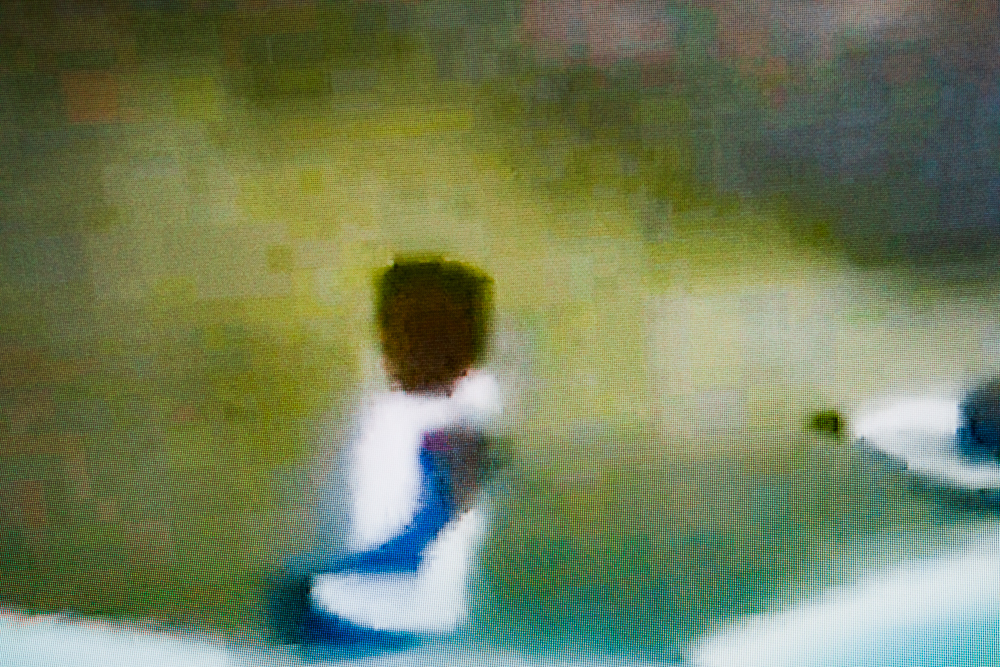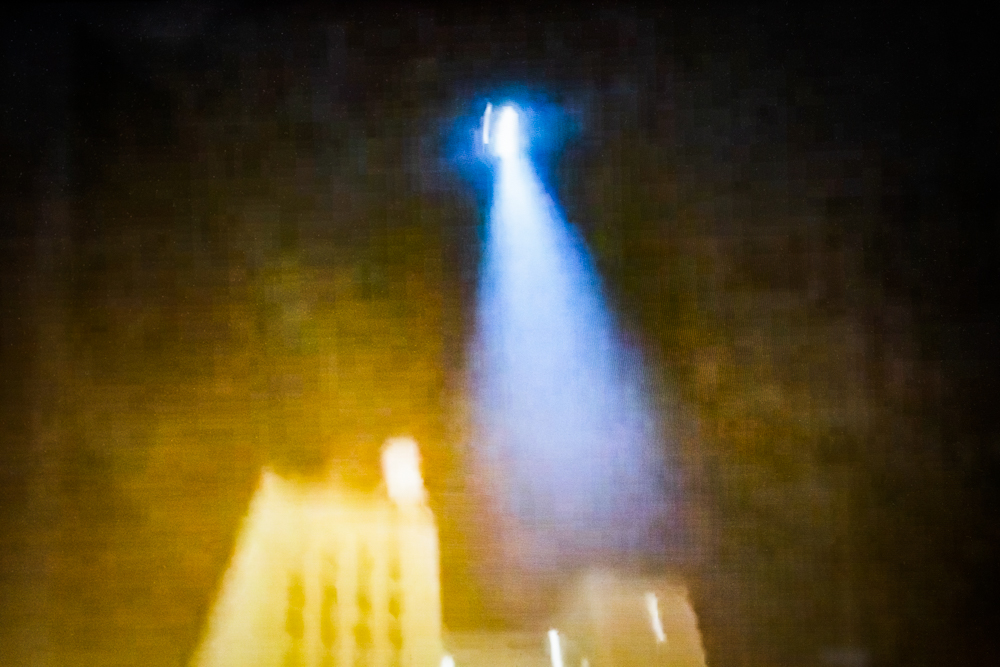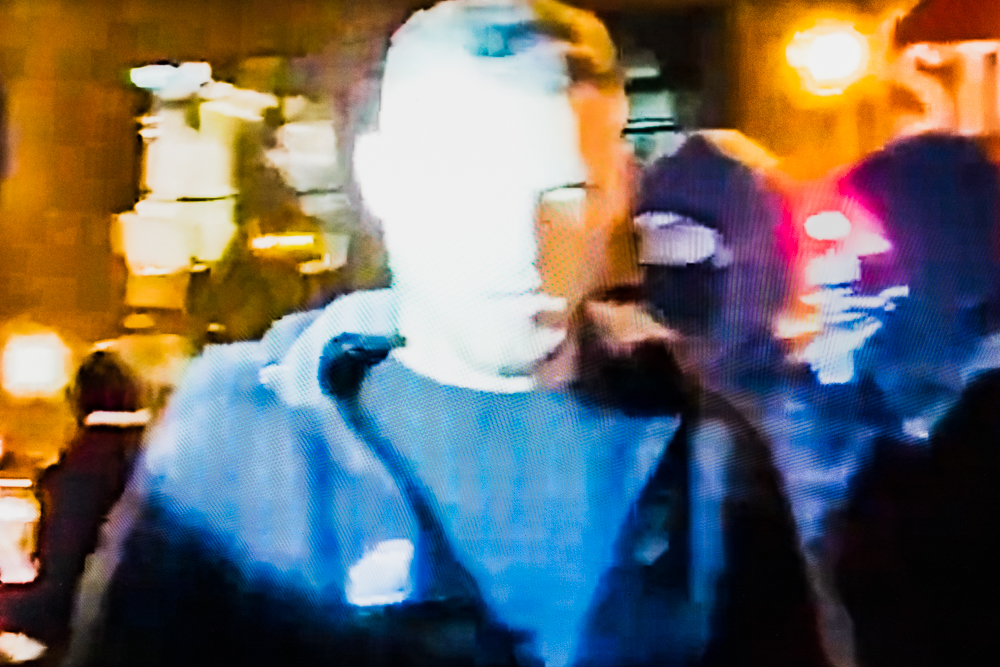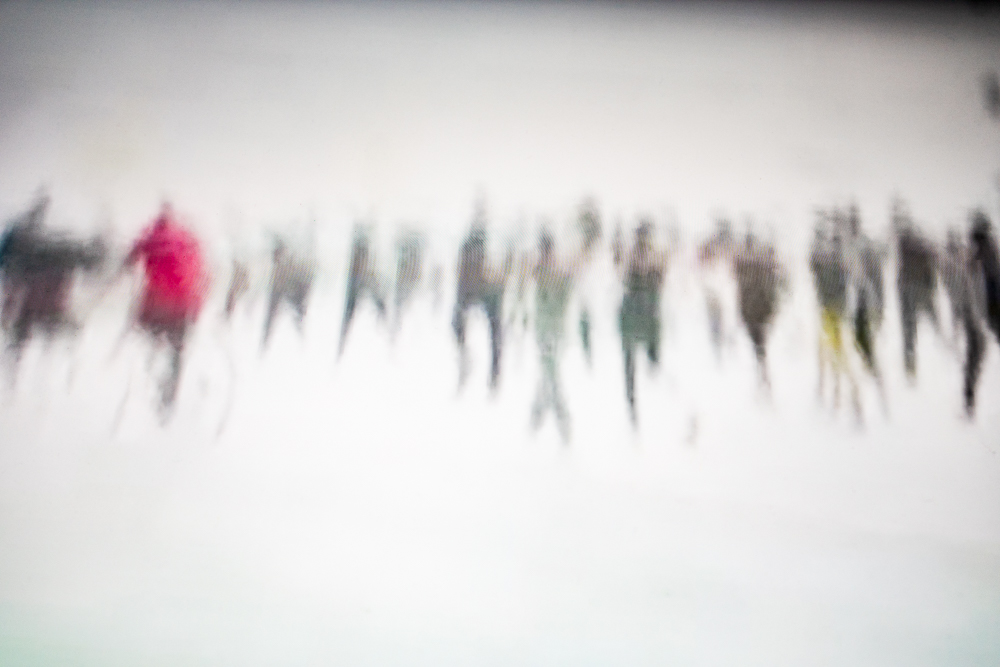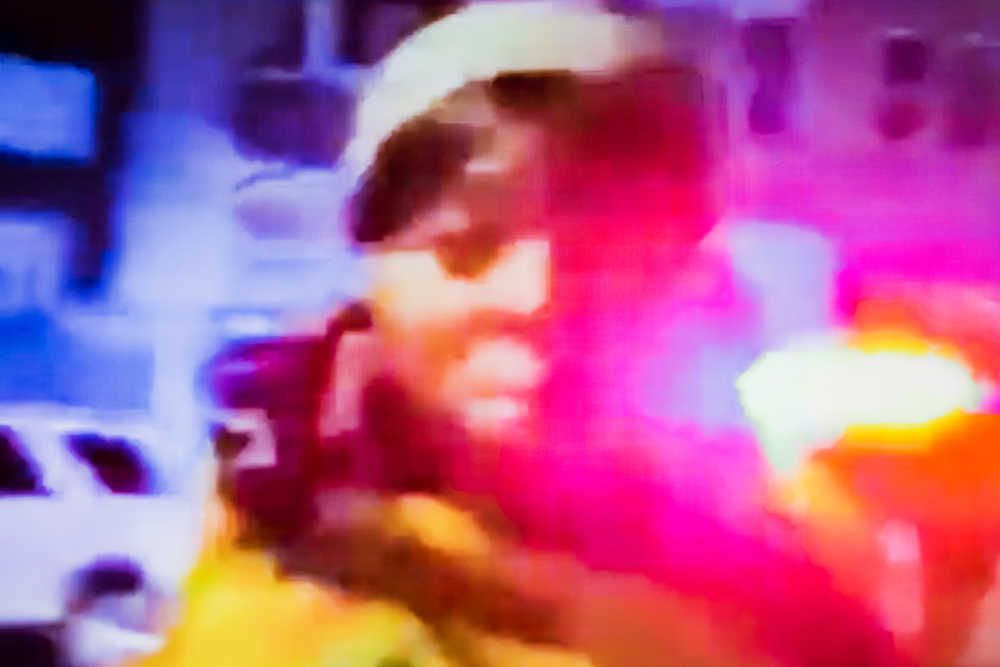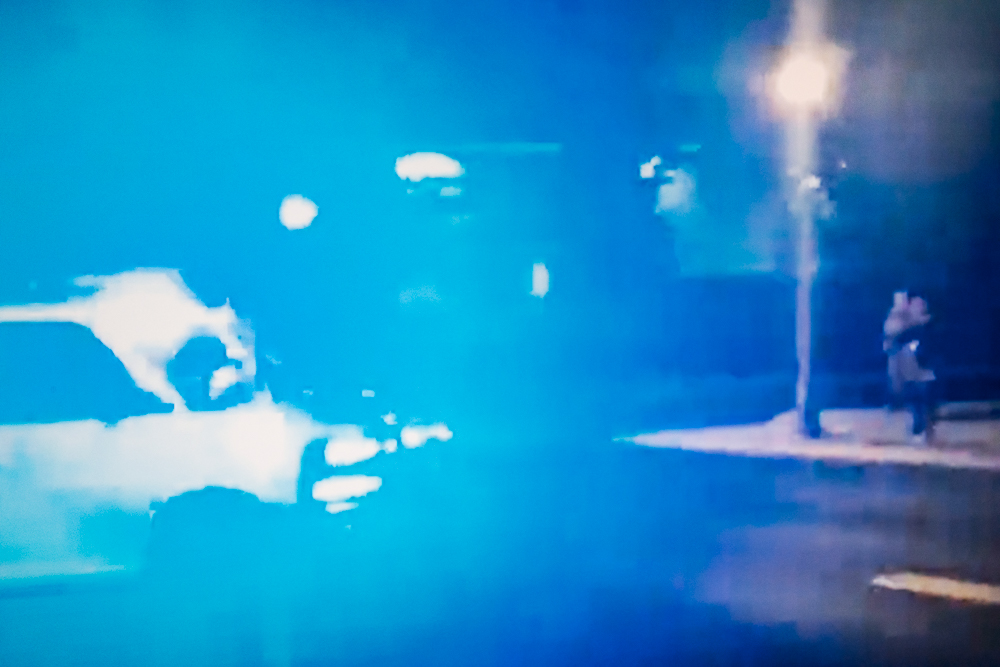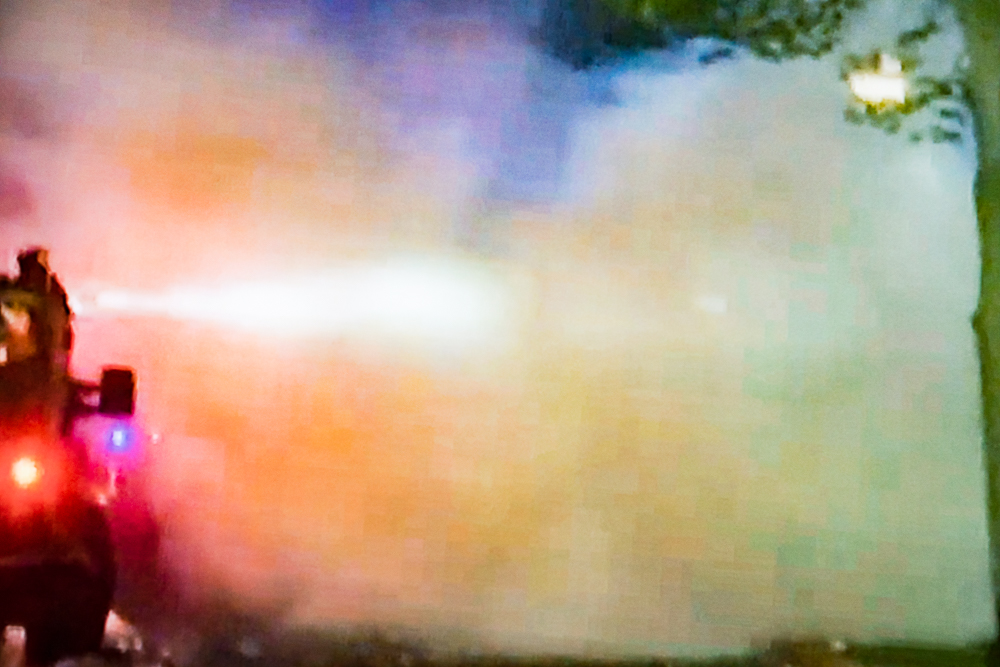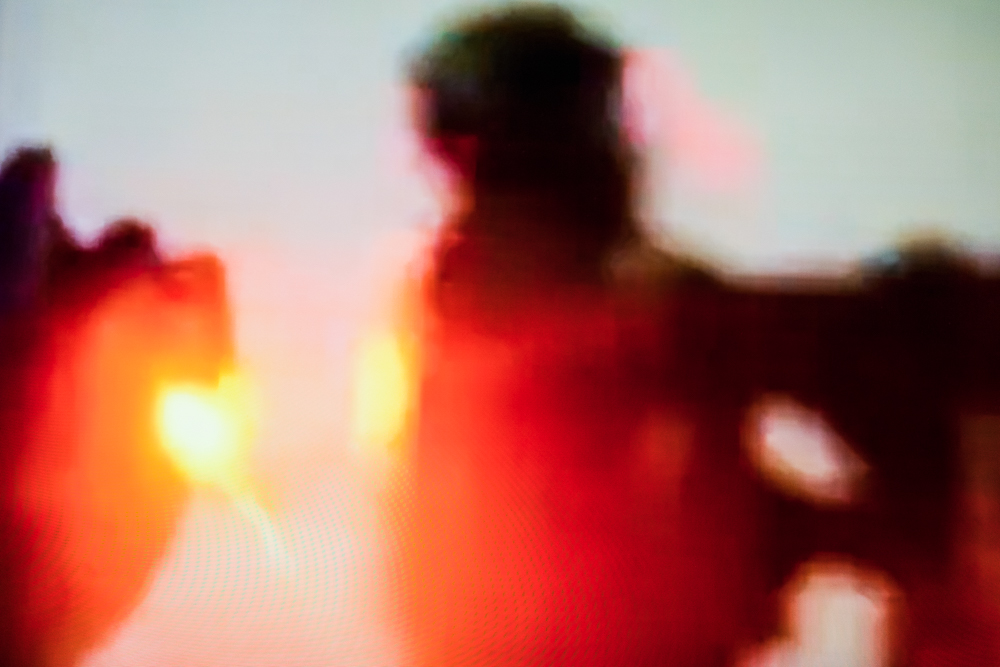PROOF: On Screen: A Conversation with Matthew Kamholtz
This week we are considering projects that all provide a form of proof. Each artist considers the idea from a different perspective.
“These pictures were born of necessity,” Matthew Kamholtz declares in the introduction to On Screen, his remarkable first photo book, self-published in 2021. Health concerns required Kamholtz to shelter in place as the Black Lives Matter protests raged in many US cities in response to the ongoing epidemic of police killings. Despite not being on the street himself, he felt a need to respond photographically and created proof of this moment in time. The pictures in On Screen were shot entirely from his home, derived from online streams and broadcast videos. The results are a beautiful, otherworldly nightmare which in its fresh language doesn’t recall any other protest coverage from the past or present day. I first met Matthew when we were both participants in a 2017 workshop in Washington, D.C., led by the former Magnum photographer Jeff Jacobson. Matthew’s work was smart and unusual, so I was delighted when he chose to join my own “Music Over Truth” online workshop in late 2020. The body of work that became ON SCREEN was well underway by then, and together with two other longtime Jacobson workshop alums, Lori Barra, and Marc Caceres, I marveled at the power and freshness of his evolving edit. Jacobson had passed away from cancer only months before, in August of 2020, and all of us felt him as a tangible presence in our weekly Zoom meetings, holding us to high standards, as he did himself. I reunited with Kamholtz via Zoom to talk about the resulting book on November 23rd, of 2021.
ON SCREEN is available for purchase at https://matthewkamholtz.bigcartel.com/product/on-screen
Matthew Kamholtz was born in Brooklyn, New York, in 1953 and graduated from the State University of New York at Stony Brook in 1974 with a degree in Music and Philosophy. After working in New York City as a picture framer and pianist he relocated to Boston, Massachusetts, where he attended Boston University School of Law, graduating in 1982. For 35 years he worked in the Boston area as a criminal defense lawyer, primarily representing indigent clients. He lives with his wife in Brookline, Massachusetts.
Kamholtz began to seriously study photography in 2007 when he attended a workshop with David Harvey. Since then, he has participated in workshops with other photographers working in the broad documentary tradition, including Nikos Economopoulos, Jeff Jacobson, Constantine Manos, and Alex Webb.
His work has been exhibited at the Griffin Museum of Photography, Danforth Museum, Falmouth Art Center, Minneapolis Photo Center, PhotoPlace Gallery of Marlboro, Praxis Gallery of Minneapolis, Rockport Art Museum, the Photographic Resource Center of Boston, and the 20/20 Photo Festival of Philadelphia. In 2019, he was awarded a grant by the Massachusetts Cultural Council.
In 2021, his self-published book, On Screen, was exhibited at the Davis Orton Gallery and the Griffin Museum of Photography.
Follow Kamholtz on Instagram: @mkamholtz
On Screen
Throughout the Summer and Fall of 2020, as the Covid-19 epidemic raged and the streets exploded in mass protests over the epidemic of police killings, I created a series of images by photographing television and computer screens as the protests, and the often brutal police reaction to them, played out on television newscasts, live streams, and video uploads. The images represent my photographic response to these events as I was obliged to shelter at home due to the pandemic.
This highly mediated photographic process, full of digital artifacts and partially resolved images, distorted reality, but paradoxically revealed the intensity and emotion of the scene as well. Although I was physically distant, the images feel intensely present.
The complete body of work of 75 images has been collected in a self-published monograph, entitled On Screen. The images depict events that occurred Atlanta, GA; Boston, MA; Brockton, MA; Brooklyn, NY; Chicago, IL; Detroit, MI; Kalamazoo, MI; Kenosha, WI; Lafayette, LA; Louisville, KY; Minneapolis, MN; New Orleans, LA; Omaha, NE; Philadelphia, PA; Portland, OR; Providence, RI; Raleigh, NC; Richmond, VA; Rochester, NY; Seattle, WA; Vancouver, WA; Washington, D.C.; Wauwatosa, WI; and Wolf City, TX.
RR: In late 2020 when you were in my photo workshop it seemed that the “voice” of ON SCREEN was already well-established, despite still being a work in progress. Can you talk about how that vocabulary developed as you explored shooting police and protester clashes from your TV and computer screens?
MK: Well, I’d been shooting off the screen for a while. I think I probably started in 2015, before the election. I was shooting the Presidential debates. It was just really fun for me at that point to find a really huge TV, and get really close to the screen. The lens I was using––I could focus within nine or ten inches from the screen––I could get really close. And I was playing around with distorting the images of the candidates. If you tilt the camera a little, their faces kind of blow up, those kinds of things. So, I was just having fun with that. And I did a fair amount of it, photographing Trump and the other candidates. So I was very used to doing it. I was comfortable doing it.
Actually, I had taken a really interesting picture––I don’t know if you’ve seen it. It was a picture of Elizabeth Warren, during the debates before the New Hampshire primary, I was in a workshop with Jeff [Jacobson], up in New Hampshire and I wound up going to a bar where there was a watch party for the debate, and they had one of these huge projection TV screens. The people in the bar were not that interesting to me, but the screen was really fascinating. These TV projectors–– when you take a short exposure you get these crazy bands of color. It’s just weird! I mean, it was kind of wonderful shooting it. So, that solidified my thinking, that this was an interesting thing to do.
RR: Can you talk about some of the things you were discovering as you were experimenting at that time?
MK: One thing is just the shutter speed, because when you’re shooting a screen, the image is not fully realized on the screen at the moment of exposure, because––particularly with those projection screens––I don’t know what their refresh rate is, but it’s very slow. So if you take an exposure that is some fraction of a second you get these weird, weird effects. But it’s also the case, when you’re shooting a TV or computer screen, that the image isn’t there all at once. It’s kind of scanned or interlaced in, and I think different TVs do it in different ways. So I started playing around with that. I think I vaguely remember from the days of CRT TVs that you had to shoot at like a 60th of a second. Somehow I had in my mind that different shutter speeds would give you different effects. And so I started to just play around with different shutter speeds to get different kinds of effects.
When the demonstrations started happening, I guess it was in May, 2020, I just really felt that I had to photograph this, somehow I realized that. So as I started shooting the screen, at first it was mostly news reports. And I saw that it was going to be all about framing for me. I’ve got a pretty big computer screen and the TV is maybe 30 or 40 inches, but the larger the screen is in front of you, the easier it is to get close so you can just frame the interesting parts. And so that’s what I started doing. What was new for me really, was having a fairly large image on the TV or computer screen and just moving in on fragments. If you want to talk about vocabulary, that’s really what it is, it’s finding the small part of the image that is going to be interesting as a photograph.
RR: Part of framing in real life circumstances and trying to make compelling images involves changing your proximity to what’s going on and the angle to things to create compositions. Was it hard to find your kind of frames in fragments of the screen rather than dealing with objects in space the way we usually do?
MK: That’s kind of funny because I found myself doing that, you know, moving around and expecting a parallax effect to happen. But it didn’t! So, that was a little jarring at first, because I was doing all that and it didn’t work. I’m photographing a two dimensional thing, you know? So in a sense, it’s like a collaboration with the person, whoever it is, who’s got the video camera or is out there with his iPhone, moving around. And so I kept on asking them in my mind, asking this guy to please move this way! [LAUGHS] But no, after a while, I didn’t find it difficult to find pictures. In fact, I was sort of overwhelmed with the number of pictures that were there. I took thousands and thousands of pictures. And the workshop really helped to edit down what I had done. But I was able to find pictures that––I don’t know whether they resemble my other pictures––but in a way they do. No matter what I’m shooting, all I’m ever looking for is something that is compelling graphically. And I’ve got this sort of magical-thinking theory, that if you manage to create an image that’s visually compelling, that somehow the emotional content will then hit you stronger, or will reveal itself. And so that’s kind of what I was looking for in the first instance, making the pictures, just looking for something that was graphically and visually interesting, and then in the editing process, finding the ones that really had the emotional content, the ones that kind of just jumped off the screen.
RR: I wonder about your thoughts on the function of the ambiguity of the individual images. Even though we know they’re depicting conflicts between protesters and police for the most part, we don’t necessarily know in every picture exactly what’s going on, the pictures leave a lot to your imagination.
MK: I struggled with the idea of whether or not to caption the pictures. In the end, I decided not to. I’m not sure if that was correct or not, because the pictures are so ambiguous that maybe that jarring effect will be even more pronounced if you spell it out just a little bit. So I thought about that, and as I worked on this over a period of many, many months, I think the pictures got more ambiguous and more abstract. When I started out, you know, they were clearly pictures of people confronting the cops, and those pictures became less interesting to me. As I looked at the whole body of work I left a few of them in there just to give it that context. But for me, the most powerful pictures are the ambiguous ones. They really work when you get that sense of beauty and horror, right in the same picture. And maybe a caption helps to explain what the horror is a little better, particularly in the very ambiguous pictures. I don’t know. I guess I still haven’t quite decided what the best result is.
RR: I’m always worried that captions will have the opposite effect that they’ll turn off that imagination in people, that if they see the caption and the thing is explained to them, the balance will lean more to the horror than the beauty.
MK: I mean, I agree with you, except I don’t know, like there’s this one picture in particular. [shows PAGE 43 of ON SCREEN] To me, that is an eerily beautiful picture. In fact, that’s Jacob Blake in the middle, and the figure on the right is a cop holding a gun with two hands. It’s Blake’s back and Blake is in the process of running around his car. And what happened was he ran to the driver’s side of his car and the cop followed him and shot him in the back. So this is the cop that is seconds away from shooting him. Does it help to know that? I don’t know. I do think the pictures can stand on their own.
RR: Were you just shooting the video streams in real time as they unfolded, or were you experimenting with freezing video to find images? Did you go back over things you’d possibly missed as the video played?
MK: When I first started doing it I was shooting TV news right as it happened. Then I realized that there was all this stuff on YouTube. Thousands and thousands of videos that people would post and I could play those on my computer. Sometimes I would play them and shoot directly off the computer. Sometimes I would attach the computer to the TV and watch the video on the TV because the TV is actually lower resolution than the computer screen, so I could see all the little pixels and stuff. And then somewhere along the line, probably about halfway through making the work, I realized that I could stop the video and frame it and take multiple pictures of the scene. It’s definitely different than shooting out in the street. So, some of the pictures in the book are me catching it as the video is going, some of them are frozen. I did it all ways and I was happy with the results from each, and actually I think they’re all perfectly valid. When the screen was frozen, it was interesting to view it as almost shooting a landscape or something that’s static.
RR: You dedicated the book to the memory of Jeff Jacobson. Can you talk about his influence on you in general, and on this work in particular?
MK: I’ve taken a lot of workshops, too many, probably, but I didn’t really feel like I was growing much as a photographer until I met Jeff. I think that was 2014. And he just got me thinking about photography in a totally different way, looking at every frame and really trying to understand why some pictures work and some don’t. And this idea that somehow the emotional content of the picture is going to express itself through the form of the picture. I mean, I think that’s really what I took away from him.
So, I was in touch with Jeff and we were emailing back and forth when I started doing these pictures. I knew it was something new for me, and I thought that Jeff would be interested in them, and I really wanted to know what he thought. Like, was I totally out to lunch? I really wanted his opinion. So I emailed him some images and I didn’t hear back which was very unusual. And then I did hear back after a couple of weeks, and he really loved it, and then I emailed again, I didn’t hear back and and it was at that point that I then got an email from Marnie [Andrews], Jeff’s wife, saying that he was in the final stages of brain cancer, which had developed very rapidly. We actually did a Zoom call and he looked at some of the pictures. He was not able to respond very much at that point, but he was very much on my mind. He was dying and unable to communicate, only sporadically coherent. So he was very much in my thoughts and was kind of hovering around the edges of what I was doing. I know he was. There was a lot going on politically, and there was a lot going on with me emotionally because of that. But I really felt that his presence was a part of what I was doing. As I was editing I could hear his voice in my head.
RR: Jeff was always a big advocate for finding the picture other than the one you’re supposed to take. When you’re seeing with your knowledge as well as your eyes, you’re telling yourself what’s “important” but there’s so many other possibilities. And it seems like for you to make these pictures there had to be a lot of letting go of those more literal descriptions of facts. I wonder if you think you were in a way preparing for that in the years previous through working with Jeff and how he approached editing.
MK: I definitely think that’s the case. I found myself shedding more and more of those literal pictures, and I’m sure that was a lot to do with Jeff’s influence. Absolutely. But, it wasn’t hard at all, because I think it’s just clearly the case that the more literal pictures just aren’t as good. Those pictures seem to be telling you what to think and telling you what to feel. And I just don’t feel as much, looking at them. What I was looking for, getting down to the final stages, was totally the emotional content of the pictures. I mean, I think that’s what the content of a picture is, is how it makes you feel. I mean, it’s got a formal aspect which I think about a lot when I’m editing and when I’m shooting, but the content of the picture is what it makes you feel, not information, I don’t think pictures give you information. I think they give you a door to your emotional world.
RR: How did that carry over to deciding on the sequence of the images?
MK: When I first started thinking about a sequence I thought of making a slideshow. So I started thinking about music and I wound up using the slow movement of Elliott Carter’s second string quartet. I don’t know if you know it, but it’s an amazing, gut wrenching thing that kind of goes up and down and up and down emotionally. So I thought, let me just play with this and see if I can make a sequence that would work with the music. Now, that music is very long for a slideshow. It’s like 13 minutes. And at that point, I had something like a hundred and twenty pictures. So I played around with it, and it was really interesting to do that, but there were too many pictures. And if I wanted to use that music with a fewer number of pictures, it wouldn’t move along. It just wouldn’t work. But I thought the music was terrific and and it made me see the pictures in a different way, because the music is moving towards some kind of an emotional climax, and I could see which pictures would work together that way. It just gave me a new way of thinking about the pictures. It was a very meaningful exercise for me to do, but I didn’t use that sequence at all for the book. In the end I decided to just try to pair the pictures visually, except at the very end where they become more ethereal. Actually that is something that I got from the Carter piece, which just kind of dissolves. And so I kind of went with that idea in the sequence for the book. But, for the most part, I just looked for pairs of pictures that I thought would work well together.
RR: I love that the vocabulary of ON SCREEN embraces the limitations that made a lot of us resistant to digital photography at first, noise or pixelization, but here these same liabilities, maybe not created by the camera as much as it is by the TV screen, are now an advantage. A part of the language.
MK: That may be also something that I got from Jeff, frankly, because he talked a lot about what happened when Kodachrome got discontinued and the medium that he worked in for his whole photographic life was no longer there. But when he embraced digital, he did it with this little camera that has lots of noise. And, you know, he really did embrace it. I mean, he exploited the defects of that camera to make incredible pictures. So yes, I was taking very high resolution pictures of low resolution images with lots of digital artifacts.
RR: I don’t know what you think of this, but I find as I get clearer about my photographic language, there’s a lot of work I’m throwing away or not showing that are objectively good pictures, like good reportage or good portraits or whatever. But they don’t have that certain something that I’m looking for. It’s really hard as you raise the bar because what you’re letting go of is not simply garbage. It’s easy to let go of crap pictures, but when you’re having to let go of quality images because it doesn’t fit your direction, it’s very difficult.
MK: I think that’s right and I found myself doing it a lot. I mean, this project for me was so immersive. It was all I was doing for hours and hours and hours, every day, and all I was thinking about. And I was editing sort of on the on the go, as I was doing it. There was a new demonstration, practically a new police shooting every week or month. It was just craziness. And even when something wasn’t happening in real time, you go to YouTube and you just dig up another hundred videos to go through. But as I kept moving along, it became very clear to me what I thought I was doing. I was not doing this to be a documentarian. And so it really wasn’t important to me to have pictures that explicitly revealed what was going on. It wasn’t about that at all. And so in one sense I couldn’t have done it if it weren’t for COVID, if I had been able to go out and shoot these demonstrations. I’m sure the pictures would have been way less interesting.
RR: Well, the documentarian role was already being taken care of, right? You were you were shooting your pictures from some of that very documentation. So it would have been pretty silly to just duplicate what the people on the ground were already doing.
MK: Right. And by the way, when you asked me earlier about finding your vocabulary, one of the things I realized very early on was that the only interesting pictures were going to be the ones that were from the videos that were made at night. I shot a lot of daytime stuff and it just kind of washed out. All of the pictures in the book are illuminated essentially by police lights, blue lights, red lights, flashing lights, street lights, all that stuff. And it makes for much more visually interesting results. There may be a couple of exceptions from around dusk, but for the most part, they’re all nighttime pictures.
RR: Lastly, let me ask you about how you knew where to stop with this project. How did this wrap up for you?
MK: That’s a good question. For one thing, as I kept shooting it became harder and harder for me to find a picture I hadn’t already taken in some way. And then I got the feeling that it was reaching its end. That was right at the end of 2020. Then the insurrection happened in January, and I started shooting that, and it was difficult. The outdoor pictures were really hard to make because it was this overcast day. But I did get a couple of good pictures, and I thought, well, should they be included in this? And I decided, no, it had already ended. And I guess it was that decision not to put the insurrection pictures in that made me realize it was finished, and what I needed to do then was to work with what I had, so I guess it was those two things: finding it more and more difficult to make a new interesting picture, and knowing what I thought should not be included. It makes sense now.
Posts on Lenscratch may not be reproduced without the permission of the Lenscratch staff and the photographer.
Recommended
-
Salua Ares: Absense as FormNovember 29th, 2025
-
Ricardo Miguel Hernández: When the memory turns to dust and Beyond PainNovember 28th, 2025
-
Pamela Landau Connolly: Columbus DriveNovember 26th, 2025
-
KELIY ANDERSON-STALEY: Wilderness No longer at the Edge of ThingsNovember 19th, 2025
-
Jackie Mulder: Thought TrailsNovember 18th, 2025

